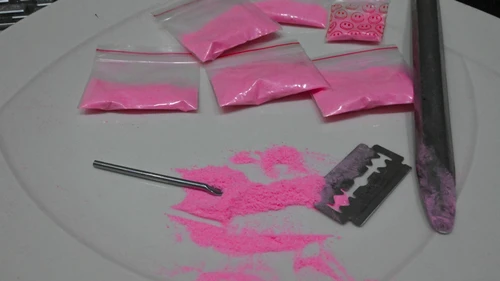There is a lot of misinformation about the strawberry-scented pink powder: it is actually a mix of MDMA and ketamine, the symbol of a new generation of narcos.
A bright pink mix of ketamine and MDMA from Colombia is spreading across Europe.
The drug, known as “tusi” (from the English pronunciation of ‘2C’)—and dubbed “pink cocaine” by the media and police even though it doesn’t contain cocaine—is increasingly appearing in police seizures in Spain, and is also emerging in other European countries.
In the big cities of Colombia, this substance has become the symbol of a new generation of young narcos who produce it and circulate it in the circles of clubbing and sex tourism.
On the market it is sold as a more exclusive stimulant than cocaine, taking advantage of its unmistakable colour. In fact, tusi is more of a brand than a specific substance.
The pink powder appeared on the roads of Colombia around 2010, is dyed with a food coloring to distinguish it from other powders, and often smells like strawberries. It took on the name of “tusi” because it also contained, among other things, the psychedelic compound 2C-B.
But over the years laboratory tests have shown that the mix that composes it is now unpredictable; it usually contains varying amounts of caffeine-cut ketamine and MDMA. The product, made in clandestine home laboratories, varies according to the “cook” and can contain a broad spectrum of drugs, such as benzodiazepines, methamphetamine and synthetic cathinones—but there are also unproven rumors that it may also contain fentanyl. It is therefore false what we read about the alarmist articles of various online newspapers that say that pink cocaine is all 2C-B—indeed, the hallucinogen synthesized by Alexander Shulgin in 1974 is rarely present in the tusi cocktail.
Those who use it report an effect that combines the sedative and psychedelic component of ketamine with the stimulating one of MDMA and caffeine.
Recently, the Spanish police announced the arrest of seven members of a criminal cartel that distributed cocaine and tusi in Madrid and Malaga by importing them by air from Latin America. A search of their homes in Spain resulted in the seizure of 8 kg of what officers called “pink cocaine”, as well as regular cocaine and cash.
Pink Cocaine
In August 2022, the police found 13 kg of what they called “pink cocaine”, probably the largest seizure of tusi ever made in Europe, in Ibiza, together with cocaine and ketamine, 440,000 euros in cash and a machine gun . Of the 12 people arrested, the majority were British citizens, while two were Colombian. Over the summer, news of a batch of tusi laced with fentanyl that allegedly caused a wave of overdoses on the island sparked panic on social media, but was later proven false. Last May, police found a clandestine laboratory in a town outside Madrid that was being used to produce pink cocaine.
According to a UN report on the rise of illegal ketamine trafficking published in late 2022, Tusi was spotted at a music festival in the UK, but also in Austria and Switzerland during the year. In July, a Colombian national arrested in Italy for international drug trafficking was found in possession of tusi in his Milanese home.
Drug is Connected to The Culture
“This drug is connected to the culture of neo-drug traffickers in Colombia,” Julian Quintero, a sociologist and researcher at the Colombian NGO Social Technical Action, told VICE World News. “The best clubs and million-peso prostitutes at the most opulent parties are not in the hands of the traditional ‘patrons’ of drug trafficking, but of enterprising young people who have learned to ‘cook’ tusi in their own kitchens.” Quintero said that, with the help of the tusi, the culture of neo-drug traffickers has “wrenched the monopoly of money and beautiful women from the cocaine traffickers.”
“With tusi, any young person can become a drug trafficker. Gangster culture has been democratized.” He said that tusi is the most requested drug by foreigners who exploit the prostitution market in Medellín and Cartagena, Colombia.
The Fifth Most Common Drug in Colombia
Tusi is now the fifth most common drug in Colombia and is a regular fixture on the narco menu in countries such as Argentina, Venezuela, Uruguay, Chile and Panama.
It was perhaps inevitable that the drug would also appear in Spain, the European nation with the closest ties to the Colombian drug trade. And right there it began to circulate sporadically since 2011; one of the most substantial seizures occurred in 2016, when nine people, including some Colombians, were arrested for running a tusi laboratory on the outskirts of Madrid.
But over the past three years, experts have noted a strong growth in the product’s presence throughout Spain.
A 2022 survey of 1,412 recreational drug users by Energy Control, a harm-reduction NGO, found that one in five people had used tusi in the previous 12 months. The NGO, which also tests drugs on demand, had received only a handful of samples identified as tusi before 2019, but in the past three years it has received 150.
“Contrary to the belief that ‘pink cocaine’ is the drug of the elite, the product is used by people from all walks of life,” said Claudio Vidal, director of Energy Control. “Even if it was initially found mainly in large cities such as Madrid or Barcelona, or tourist resorts such as Ibiza or the Costa del Sol, today it has spread everywhere.”
The spread of thus is part of a slow but significant shift in the global narcotics market, in which the weight of plant-derived drugs such as cannabis, cocaine and heroin is declining, while that of synthetic lab-produced drugs, often easier to and less expensive to produce, but which—like fentanyl—can prove unpredictable and even lethal.
This article is originally published on vice.com


